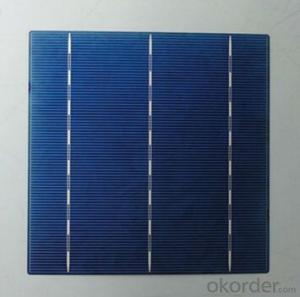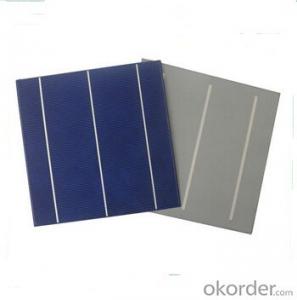Monocrystalline Solar Cells High Quality 17.2%
- Loading Port:
- Shanghai
- Payment Terms:
- TT OR LC
- Min Order Qty:
- 1000 pc
- Supply Capability:
- 1000000 pc/month
OKorder Service Pledge
OKorder Financial Service
You Might Also Like
Solar Cells:
Solar cells is made by solar wafer, it has three categories of solar cell right now, monocrystalline polycrystalline and thin film,These cells are entirely based around the concept PN junction, which is the critical part of solar module, it is the part that can convert the light energy into electricity, the thickness is from 180um to 200um, with even busbars to conduct electricity, textured cell can decrease diffuse reflection; they are often electrically connected and encapsulated as a module. Photovoltaic modules often have a sheet of glass on the front (sun up) side, allowing light to pass while protecting semiconductor wafers from abrasion and impact due to wind-driven debris, rain, hail, etc. Solar cells are also usually connected in series in modules, creating an additive voltage. Connecting cells in parallel will yield a higher current;With high quality and stable quality. Our Cells can greatly improve the performance of Solar Modules.
Features:
High efficiency and stable performance in photovoltaic conversion.
Advanced diffusion technique ensuring the homogeneity of energy conversion efficiency of the cell.
Advanced PECVD film forming, providing a dark blue silicon nitride anti-reflection film of homogenous color and attractive appearance.
High quality metal paste for back surface and electrode, ensuring good conductivity, high pulling strength and ease of soldering.
High precision patterning using screen printing, ensuring accurate busbar location for ease with automatic soldering a laser cutting.
Solar Cells Advantage:
• High efficiency and stable performance in photovoltaic conversion.
• Advanced diffusion technique ensuring the homogeneity of energy conversion efficiency of the cell.
• Advanced PECVD film forming, providing a dark blue silicon nitride anti-reflection film of homogenous color and attractive appearance.
• High quality metal paste for back surface and electrode, ensuring good conductivity, high pulling strength and ease of soldering.
• High precision patterning using screen printing, ensuring accurate busbar location for ease with automatic soldering a laser cutting.
Specifications:
Efficiency(%) | Pm(W) | Ump(V) | Imp(A) | Uoc(V) | Isc(A) | FF(%) |
19.20-20.00 | 4.67 | 0.547 | 8.542 | 0.64 | 9.15 | 79.79 |
19.00-19.20 | 4.63 | 0.543 | 8.515 | 0.639 | 9.11 | 79.43 |
18.80-19.00 | 4.58 | 0.542 | 8.441 | 0.638 | 9.1 | 78.8 |
18.60-18.80 | 4.53 | 0.54 | 8.382 | 0.637 | 9.084 | 78.23 |
18.40-18.60 | 4.48 | 0.536 | 8.354 | 0.636 | 9.062 | 77.7 |
18.20-18.40 | 4.43 | 0.533 | 8.31 | 0.635 | 9.033 | 77.22 |
18.00-18.20 | 4.38 | 0.532 | 8.234 | 0.634 | 8.987 | 76.88 |
17.80-18.00 | 4.33 | 0.529 | 8.189 | 0.633 | 8.951 | 76.45 |
17.60-17.80 | 4.29 | 0.527 | 8.128 | 0.632 | 8.922 | 75.96 |
17.40-17.60 | 4.24 | 0.525 | 8.066 | 0.629 | 8.902 | 75.63 |
Packaging & Delivery of Solar Cells
Carton Box Package and Deliver by air. It should be noticed that it should be avoid of water, sunshine and moist.

FAQ
We have organized several common questions for our clients,may help you sincerely:
①What price for each watt?
It depends on the efficiency of the solar cell, quantity, delivery date and payment terms.
②How long can we receive the product after purchase?
In the purchase of product within three working days, We will arrange the factory delivery as soon as possible. The pecific time of receiving is related to the state and position of customers.Commonly 7 to 10 working days can be served.
③Can you provide the peripheral products of the solar panels, such as the battery, controller, and inverter? If so, can you tell me how do they match each other?
Yes, we can, we have two companies for solar region, one is CNBM International, the other is CNBM engineering Co.
We can provide you not only the solar module but also the off grid solar system, we can also provide you service with on grid plant.
④What is your warranty of solar cell?
Our product can promise lower than 0.3% open box crack, we support claim after opening the box if it has crackm color difference or sth, the buyer should give pictures immediately, we can not accept the claim after the solar cell has assembled to solar panel.
• Timeliness of delivery
• ⑤How do you pack your products?
We have rich experience on how to pack the solar cell to make sure the safety on shipment, we could use wooden box or pallet as buyer's preference.
- Q:What is 3d solar cell? And anybody know any manufacturers?
- 3d solar cells are more high efficient than the usual solar cells, and it's a new developed technology which is not used very widely. Therefore, there are not many manufcturers are producing it.
- Q:How do solar cells handle voltage fluctuations?
- Solar cells do not handle voltage fluctuations directly. However, to manage voltage fluctuations, additional components such as voltage regulators or inverters are used in conjunction with solar cells. These components help stabilize and regulate the voltage output from solar cells to ensure consistent and reliable power supply.
- Q:Can solar cells be used on boats?
- Yes, solar cells can be used on boats. They are a reliable and efficient source of renewable energy that can power various electrical systems on board, including lighting, navigation equipment, and charging batteries. Additionally, solar cells are lightweight, durable, and environmentally friendly, making them an ideal choice for boating applications.
- Q:Can solar cells be used in residential homes?
- Yes, solar cells can be used in residential homes. They are a sustainable and renewable energy source that can generate electricity by converting sunlight into usable energy. Installing solar panels on residential rooftops allows homeowners to generate their own clean energy and reduce their reliance on traditional fossil fuel-based electricity.
- Q:What is the role of power optimizers in solar cell systems?
- The role of power optimizers in solar cell systems is to maximize the energy output of each individual solar panel by ensuring that it operates at its maximum power point (MPP). Power optimizers achieve this by mitigating the effects of shading, module mismatch, and other factors that can decrease the overall performance of the system. They also enable panel-level monitoring and provide important data on the performance of each individual panel, allowing for more efficient maintenance and troubleshooting.
- Q:How do solar cells perform in different temperature ranges?
- Solar cells generally perform better in cooler temperatures. As the temperature increases, the efficiency of solar cells tends to decrease. However, the actual performance can vary depending on the specific type of solar cell and its design.
- Q:Can solar cells be used in boats or marine applications?
- Yes, solar cells can be used in boats or marine applications. Solar panels can be installed on the deck or roof of a boat to harness the power of the sun and convert it into electricity. This electricity can then be used to power various onboard systems such as lights, navigation equipment, communication devices, and even recharge batteries. Solar power offers a sustainable and environmentally-friendly energy solution for boats, reducing reliance on traditional fuel sources and minimizing the carbon footprint of marine activities.
- Q:How do solar cells perform in low-light conditions?
- Solar cells perform less efficiently in low-light conditions compared to bright sunlight. This is because they rely on sunlight to generate electricity through the photovoltaic effect. In low-light conditions, the reduced intensity of sunlight results in lower electrical output. However, advancements in solar cell technology have improved their ability to work under low-light conditions, allowing them to still produce some electricity even in cloudy or shaded environments.
- Q:Can solar cells be used in vehicles?
- Yes, solar cells can be used in vehicles. They can be integrated into the design of cars, buses, boats, and even airplanes to convert sunlight into electricity, providing power for various vehicle functions such as charging batteries, running onboard systems, or even powering the entire vehicle.
- Q:What is the role of surge protectors in solar cell systems?
- The role of surge protectors in solar cell systems is to protect the system from voltage spikes or surges that can damage the solar panels, inverters, or other sensitive electronic components. Surge protectors help to regulate and divert excessive voltage to prevent equipment failure and ensure the overall stability and longevity of the solar cell system.
1. Manufacturer Overview |
|
|---|---|
| Location | |
| Year Established | |
| Annual Output Value | |
| Main Markets | |
| Company Certifications | |
2. Manufacturer Certificates |
|
|---|---|
| a) Certification Name | |
| Range | |
| Reference | |
| Validity Period | |
3. Manufacturer Capability |
|
|---|---|
| a)Trade Capacity | |
| Nearest Port | |
| Export Percentage | |
| No.of Employees in Trade Department | |
| Language Spoken: | |
| b)Factory Information | |
| Factory Size: | |
| No. of Production Lines | |
| Contract Manufacturing | |
| Product Price Range | |
Send your message to us
Monocrystalline Solar Cells High Quality 17.2%
- Loading Port:
- Shanghai
- Payment Terms:
- TT OR LC
- Min Order Qty:
- 1000 pc
- Supply Capability:
- 1000000 pc/month
OKorder Service Pledge
OKorder Financial Service
Similar products
New products
Hot products
Hot Searches
Related keywords


























